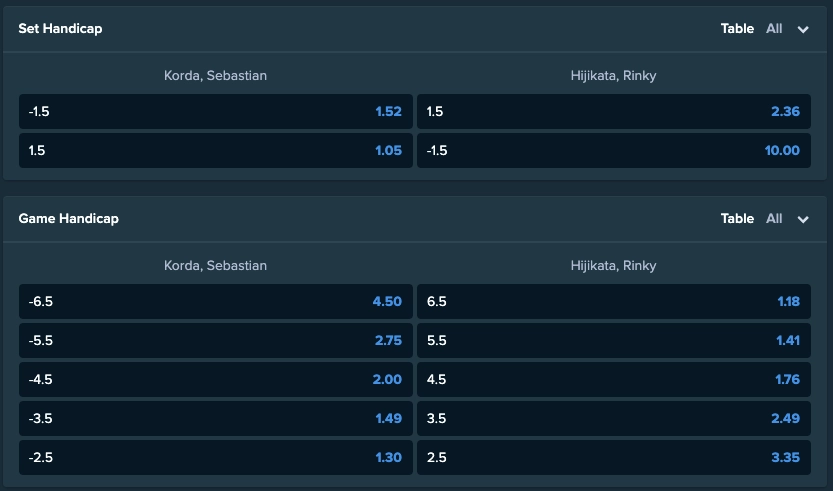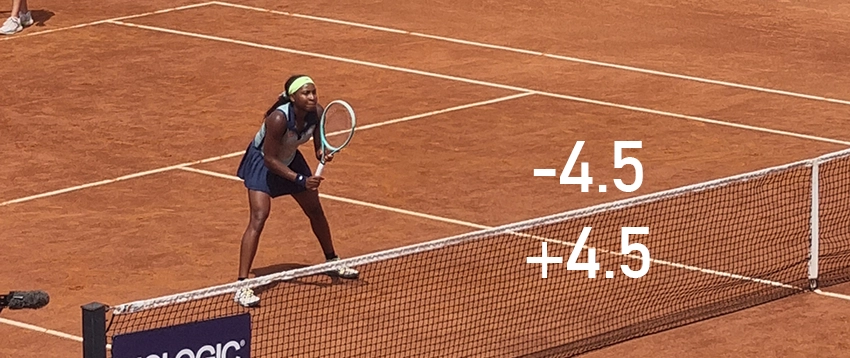For those who have been around the sport for long enough, you might have heard of HCP betting in tennis. Ever wondered what it means? Let’s find out.
Hcp betting is shorthand for “handicap betting”, and refers to a certain genre among betting markets. It’s a common approach that bookmakers employ across many different types of sport, including tennis, and is done as a means of leveling the playing field in a match.
Below, we break down everything you need to know about handicap betting in tennis. From explaining how this betting market works, through to the different types of handicaps that exist in tennis, and when it’s best to bet with hcp in tennis matches.
How does handicap betting work in tennis?
In its simplest form, handicap betting involves adding or subtracting games from a player’s total at the end of a match.
This is best explained with an example.
Say that Carlos Alcaraz plays Pedro Cachin in the first round of Wimbledon this year. This match is not expected to be close, Alcaraz is defending champion, while Cachin is outside of the world’s top 100.
Because of this, bookmakers give Alcaraz a -8.5 handicap at odds of 1.91 (-110), and Cachin a +8.5 handicap at the same odds.
This means that if you back Alcaraz at a -8.5 handicap, the Spaniard will need to win by nine games or more in order for you to receive your return of 1.91 (-110). Equally, if Cachin loses, but does so by eight games or less, then those who backed him at -8.5 will receive a payout.
For example, Alcaraz wins 6-4, 6-4, 6-3. Alcaraz has won 18 games, while Cachin claimed 11. If we then subtract 8.5 from Alcaraz’s total games, the game score now reads 9.5 to 11. As a result, those who bet on Cachin’s handicap will win.

Is there more than one type of tennis handicap betting?
Handicap betting in tennis is most commonly found in the form described above, known as a match handicap.
However, the concept can be taken and applied to almost any betting market in tennis. Other common examples are ace handicaps, double fault handicaps, or even set handicaps.
Typically, handicaps will be set at a point where the tennis bookmakers are willing to offer equal or close to equal odds. In the example above, Alcaraz is given quite a significant handicap, because of the gap between him and Cachin ranking-wise. Other matches might see a smaller handicap of only +/- 1.5, if the two players are close in ability already.
Sometimes, bookmakers offer a range of handicaps at different odds (as in the screenshot above).
For example, against Cachin, a handicap might be offered for Alcaraz at +10.5 as well, with a more lucrative return of 2.50 (+150). A more conservative handicap could also be given at +6.5, with a lower payout of 1.50 (-200).
A quick note on terminology: handicap betting is known by a range of different names. It can also be referred to as spread betting, points betting, line betting or even Asian handicap.
When is the best time to bet on a handicap in tennis?
So what’s the point of handicap betting in tennis? When should it be used?
The first instance where handicap betting is valuable is when you think an underdog will lose, but perform well.
Say you’ve been following Cachin for some time at the Challenger level, and believe he’ll punch above his weight against Alcaraz. You don’t necessarily believe he’ll beat the three-time Grand Slam champion, but you do think he’ll put up a stiffer contest than people are expecting.
That’s when you want to bet the handicap on Cachin. Betting on him to win would still yield no return, but if he covers the handicap, then your hunch will bear fruit.
The next instance where you’d want to be on a handicap in tennis is when you think a player could either win, or come up just short.
Some examples when to consider hcp betting
For example, when Jack Draper played Carlos Alcaraz earlier this week, the Brit had a handicap of +3.5. If you thought that Draper was going to push Alcaraz and maybe even upset him, then you’d want to bet on his handicap.
That way, if Draper wins, your bet pays; but if he loses narrowly, your bet still pays as well.
Alternatively, if you believe a player is going to hand out a thrashing, you should bet on their handicap for a greater reward.
For example, Iga Swiatek was dominant on clay recently. This meant that her outright betting odds to win matches yielded very low returns. However, betting on her handicap could still generate a handy return–if she dished out a one-sided scoreline, like she often did.















